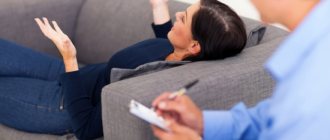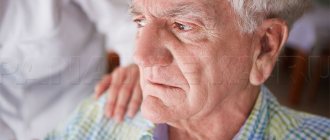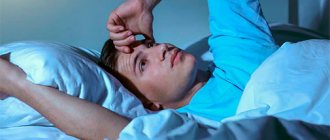Are you ready to stop thinking about your problem and finally move on to real actions that will help you get rid of your problems once and for all? Then perhaps you will be interested in this article .
Types of anxiety should not be confused with types of anxiety. The latter is a situational reaction to a stimulus, disappearing as soon as the impact stops. Anxiety is a feature of the psyche that causes a person to experience anxiety even when there is no reason for the anxiety.
Symptoms
Signs of an anxiety disorder are divided into physiological and psychological.
Physiological ones include:
- labored breathing;
- increased heart rate;
- feeling of tightness in the chest;
- heartache;
- headache;
- dizziness;
- shiver;
- general weakness;
- increased sweating;
- nausea;
- stomach pain;
- numbness of the limbs;
- violation of thermoregulation.
To the psychological:
- disorientation;
- feeling of fear.
How to overcome anxiety?
So, what to do if you find yourself with increased anxiety that is preventing you from living a normal life? Below I will give a few recommendations that will help you somewhat reduce your anxiety level on your own.
Drug therapy
Medicines can only be prescribed by a doctor! Most often, for high anxiety, sedatives of varying degrees of effect are prescribed. Infusions of valerian or motherwort have the mildest effects. They can be taken independently. In more complex cases, medications are prescribed by a doctor, and they can only be purchased at a pharmacy with a prescription!
Introspection
You can try to independently analyze the reasons that make you anxious. To do this, you need to take a comfortable position and make sure that no one or nothing interferes with you. And the main thing is a reserve of time. Immerse yourself in your thoughts and experiences. Try to understand what is happening in your life now? What events, people, problems make you anxious? What ways are there to resolve these problems? Are there people in your life that you could turn to for help? Or maybe you are missing something to feel comfortable? How could this be achieved?
Change of life situation
If anxious experiences are associated with any specific area - work, family status, social circle, try to change something in this particular part of your life. Start small; you don’t have to quit your job or divorce your spouse right away. Consider what changes available to you will bring you comfort and greater satisfaction. And try to put them into practice.
Communication. Psychologists have confirmed the fact that having a wide circle of contacts and close social connections significantly reduces the level of anxiety.
Sports activities. Many articles have been written about the benefits of exercise. Regular training has a beneficial effect on the human body, helping to release accumulated tension and switch to a positive mood. A beautiful figure is a pleasant bonus, it increases self-esteem, improves mood and, as a result, anxiety decreases.
Rest and sleep mode. Overwork is one of the causes of increased anxiety, so it is extremely important to take a weekend off, get enough sleep and get proper rest.
Sometimes you can reduce anxiety on your own. However, most often, only a specialist can help to effectively and long-term correct a high level of anxiety. By turning to a psychologist for help, you can work together to understand the reasons that make you anxious and change your life situation in the way that is most suitable for you, making it as comfortable and safe as possible.
Treatment
In medicine, the following methods are used to treat anxiety conditions:
- Psychotherapy. Consultations are often required not only with the patient, but also with those around him. In particular, collective activities are effective in relieving tension.
- Medications. Antidepressants and tranquilizers are used. Specific drugs are selected by a specialist.
- The main role in the effective treatment of anxiety disorders is played by the correct selection of the type of therapy and medications. SM-Clinic specialists remind you that self-medication can seriously worsen your psychological state.
Kinds
Types of anxiety in psychology are divided into two subtypes: situational and personal.
Situational is considered the first step. It implies anxiety, excitement, which manifests itself in a specific life situation, but does not extend to other areas of life. A person may be nervous about public speaking, but feel comfortable with informal communication.
Personality becomes part of the individual's character. He experiences a feeling of fear, awkwardness, embarrassment even in a familiar environment where there is no negative impact; gets nervous for no apparent reason. Anything can cause panic.
Anxiety is common in adults and children; it manifests itself at any age. Identifying symptoms in the early stages of the disorder, making a medical diagnosis with accompanying treatment will quickly relieve the disease. Any mental disorder is treatable.
Living with situational anxiety is difficult, but it is possible by avoiding stressful situations. But the psychosomatics of personal anxiety prevents one from performing even the simplest vital functions. In severe cases, a person experiences anxiety no matter what he does.
Conscious uncontrollable
A person suffering from this type understands that they have problems, but does not know how to deal with them on their own. Conscious uncontrollable anxiety is manifested by the following psychological symptoms:
- causeless anxiety;
- irritability, nervousness;
- decreased concentration;
- tearfulness;
- increased excitability;
- personality disorders;
- excessive experience of failures;
- desire to control;
- obsessions;
- general fatigue;
- sudden feeling of melancholy;
- social anxiety;
- mood swings;
- suspiciousness;
- sleep disorders: insomnia, nightmares, night awakenings, inability to fall asleep, restless sleep;
- timidity.
Somatic signs serve as warning signs:
- muscle tension;
- increased fatigue;
- sweating;
- chills or fever;
- difficulty breathing;
- causeless pain in the heart, muscles, abdomen;
- lack of appetite;
- stool disorder;
- tremor;
- sudden sharp pain;
- nausea;
- blurred vision;
- exacerbation of chronic diseases;
- disorders of the cardiovascular system: rapid heartbeat, headaches, changes in blood pressure, nosebleeds, dizziness.
During research, doctors do not detect pathological diseases of internal organs that could manifest themselves in this way, and prescribe medications that stabilize the state of the body, but not the psyche.
This type of anxiety disorganizes a person who is forced to structure his life in such a way as to avoid situational stimuli.
Conscious controlled and compensated
This type is considered motivating: the sufferer is aware of the problems, but overcomes the anxious state, using fear as a motivator for further activity.
For those who want to understand how to get rid of anxiety, psychologists recommend:
- Situational or permanent removal of the stimulus. If the condition occurs one-time, for example, during a conversation with an unpleasant person, you need to take a break, calm down and continue communication. In cases where manifestations of anxiety are associated with specific situations, they will have to be avoided.
- Abstraction. The cause of anxiety occupies thoughts, so to cope with a panic attack, it is replaced with something else. Concentration on an object other than the one that caused the alarm is suitable for this.
- Spilling out emotions. Anxious people keep everything to themselves. The subject may not know that he is the cause of the discomfort. Crying, screaming, hysterics or creativity relieve tension.
- Blocks. Anxiety symptoms are an extension of negative thoughts. Such ideas are blocked at the very beginning (if someone talks about unacceptable things, this monologue is interrupted). Or they come up with a way to overcome the difficulty (thoughts of quitting their job are replaced by ideas of looking for a new position).
- Breathing exercises. Taking a deep breath through your mouth, holding your breath for a short time and exhaling slowly through your nose has a calming effect on the psyche. The heartbeat will gradually slow down, the feeling of body stiffness will go away, and panic will recede. Regular breathing exercises are considered to prevent panic attacks.
- Work-life balance. A person becomes suspicious, aggressive, tense, committing inexplicable, rationally unjustified actions due to organic fatigue. You need to relax to at least give your body a break from mental activity. There should be moments of laziness in life that have a beneficial effect on mental health.
Anxiety syndrome can be compensated for, and this is the surest way to combat neurotic manifestations.
Conscious cultivated
Manipulative type - the sufferer is aware of what is bothering him, but instead of solving the problem, he draws attention to it, pursuing the goal of using a “savior”. Thus, someone who is afraid of failure shifts part of their work onto their colleagues; the person avoiding communication asks to call instead.
Are you ready to stop thinking about your problem and finally move on to real actions that will help you get rid of your problems once and for all? Then perhaps you will be interested in this article .
Psychology considers the owner of this type of anxiety to be a manipulator. Its properties:
- Excessive emphasis on symptoms: drawing attention to jitters, excessive concern about health;
- The anxiety goes away as soon as the “savior” fulfills the demands of the manipulator;
- Repeated anxiety attacks with the “savior”;
- Manifestations intensify if the manipulator is ignored;
- In case of disobedience or ignorance - hidden threats.
With this type, therapy combats neurosis and the patient’s manipulations.
Anxiety disorders are the first most common mental disorder.
Unconscious hidden
A person does not admit that he has problems, but outwardly anxiety is indicated by uncontrolled motor manifestations: nervous tics, twirling hair on a finger, tapping objects on hard surfaces. It is possible to get rid of an attack without outside help, but medical intervention is necessary: without diagnosis, causeless anxiety risks becoming chronic, turning into an anxiety syndrome.
Unconscious compensatory-protective
A person suffering from this type of neurotic anxiety does not recognize the problem, refuses to notice the symptoms, convincing himself and others that everything is fine with him.
The clearest example is postpartum depression. Nowadays it is less taboo, which is why mental disorders are detected in the early stages. But most young mothers are still sure: they cannot experience mixed feelings about the birth of a baby. Instead of going to the doctor, women believe that everything will get better with time. Signs of postpartum depression include:
More than 9,000 people have gotten rid of their psychological problems using this technique.
- apathy, feeling of hopelessness, depression;
- unreasonable disgust, groundless aggression towards a child or indifference towards him;
- outbursts of anger;
- thoughts of suicide;
- prostration.
In addition to psychosomatics, women experience hormonal surges and sudden changes in body weight, breast milk “burns out,” migraines appear, blood pressure decreases or increases, and facial numbness occurs. Without treatment, this disorder lasts up to several years, changing symptoms as it progresses.
Denying the problem only makes it worse. Treatment will require medications and work with a specialist.
Avoiding anxiety situations
This type represents the greatest danger: the patient does not recognize the anxiety syndrome, but in denial creates for himself an alternative picture of reality in which he is healthy. An example is social anxiety.
Interpersonal anxiety is a feeling of anxiety that arises during communication. Its signs:
- inferiority complex;
- expectation of failure;
- fear of criticism;
- indecision;
- fear of appearing funny;
- inability to express and defend one’s opinion;
- inability to maintain eye contact with the interlocutor;
- changes in behavior in an unfamiliar environment;
- a vague feeling of anxiety when communicating;
- reluctance to be present in crowded places.
These symptoms lead to the person isolating himself from society, creating a world for himself where there are no stress factors. He may also demonstratively refuse to accept social norms, inventing his own rules of interpersonal communication.
Prevention
To prevent anxiety disorders, a person should streamline their regimen: get enough sleep, be outdoors more often. The results of many studies show that physical activity helps to cope with anxiety: during exercise, adrenaline is released and the patient is less likely to experience causeless anxiety.
People prone to anxiety should limit their consumption of alcohol, as it has a negative impact on their emotional state.
Automotive training techniques and breathing practices have a positive effect.
If you often feel a sense of causeless anxiety and fear, do not put off going to the doctor. Qualified medical specialists will help you cope with psychological problems, get rid of phobias and return to normal life.
Why does anxiety occur?
Anxiety is influenced by a wide range of different causes. Most psychologists and neuroscientists agree that a combination of factors often plays a decisive role here, namely the combination of the innate characteristics of the functioning of the human nervous system with the influence of social and psychological factors. Here are just a few of the reasons that lead to an increase in a person’s anxiety level:
- heredity, characteristics (weakness) of the nervous system;
- improper upbringing, dysfunctional family environment surrounding a person in childhood;
- negative life experiences, numerous stresses, consequences of psychological and physical trauma;
- somatic diseases that manifest themselves in humans for a long time;
- chronic fatigue;
- low self-esteem;
- various problems and conflict situations in interpersonal relationships;
- insufficient amount (or complete absence) of physical activity and proper rest;
- abuse of alcoholic beverages, etc.
It is important to understand that if the reasons that caused increased anxiety are not related to the presence of a mental illness in a person, then it is advisable to consult a psychologist with this problem!
The difference between anxiety and anxiety
What is the difference between anxiety and anxiety? Anxiety is the human body’s response to a specific event or action. People tend to worry about their loved ones, their financial condition, and their work. But anxiety always has a specific reason.
Anxiety, unlike worry, has no specific cause. It is constantly present in the lives of individuals. Such people are characterized by nervousness, suspicion, constant anxiety, a feeling of panic, and dissatisfaction with themselves. And this makes their life unbearable.
Normal and pathological anxiety
There is so-called “normal” situational anxiety, which arises in connection with certain circumstances and does not have a significant impact on a person’s activity and quality of life. In addition, there is pathological anxiety, the main symptoms of which are:
- pronounced, constant or frequently occurring feelings of anxiety;
- discrepancy between the severity of anxiety and the circumstances that cause it;
- the influence of anxiety on human behavior and activity.
The connection between specific circumstances and the intensity of anxiety is broken. The feeling of anxiety seems to begin to live its own life, turning into a constant emotional background with sharp bursts of activity in any uncertain and unfavorable situations.
What happens?
I have already said that anxiety can be moderate (that which is only beneficial) and increased. It also happens that it is reduced.
- Moderate anxiety is a kind of internal “bell” that gives a signal as soon as you need to draw attention to something potentially dangerous. This is the norm. The level that does not cause inconvenience, rather helps in life.
- Increased anxiety is the very case when it goes “off scale.” At this level, the body cannot cope with the load and anxiety begins to be expressed in the outside world. External symptoms of increased anxiety are increased sweating and heartbeat, weakness, numbness of the limbs, tics, flatulence, a feeling of a “lump” in the throat, spasms, insomnia. It’s difficult to enjoy life in such a situation; you expect a catch around every corner.
- Reduced anxiety is the other extreme, bordering on indifference and indifference. This level is harmful because it can lead to negligence and ignorance of risk.
In addition to moderate and increased, there are personal and situational anxiety.
- That is, personal anxiety is a feature of the soul that does not depend on the current level of stress. It's always there. It is with this level of anxiety that this or that person lives. Personal anxiety can be high, low, or moderate.
- Situational anxiety occurs when stress levels increase in a relatively short period of time and is associated with new experiences. Fluctuations in situational anxiety are considered normal. Situational anxiety will decrease when stress levels decrease. If stress persists for a long time, then situational anxiety can change the overall level of anxiety.
Diagnosis of anxiety disorders
Diagnostic criteria:
To assess whether a particular patient suffers from anxiety, it is advisable to rule out the presence of a systemic disorder. To do this, the doctor must take into account the following aspects:
- Physical symptoms.
- Previous medical and psychological history of the patient and his family.
- The possibility of suffering from an illness that causes an anxiety disorder.
- The influence of toxins such as caffeine, cannabis or cocaine.
Interview:
The clinical interview is the primary tool for making a diagnosis of anxiety disorders and gaining a general understanding of the patient. It must collect the necessary information and usually consists of four stages:
- Preliminary stage: The goal is to find out the reason for the consultation.
- Exploratory phase: Symptoms, location, intensity, chronology and evolution.
- The presence of organic pathologies.
- Direct triggers such as life changes, traumatic events and so on.
- Personal history: manic episodes, previous depression, etc.
- Study of the psychosocial sphere: beliefs and expectations, thoughts, affect and social and family environment, personality.
The risk of misdiagnosis has led to a large number of structured scales to identify the disorder. These scales by themselves are not sufficient to establish a diagnosis, but they help identify people susceptible to mental pathology who need to be subjected to more in-depth study. Some of the most commonly used scales are the Goldberg Anxiety and Depression Scale and the Hamilton Anxiety Scale.











